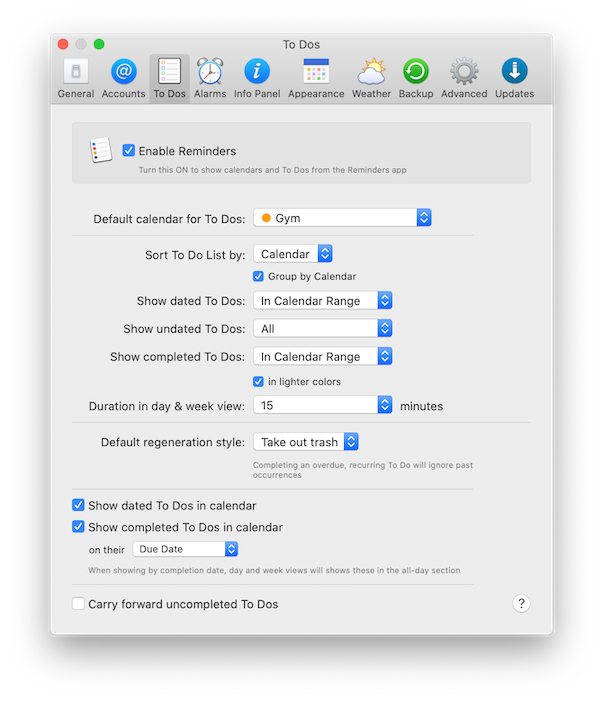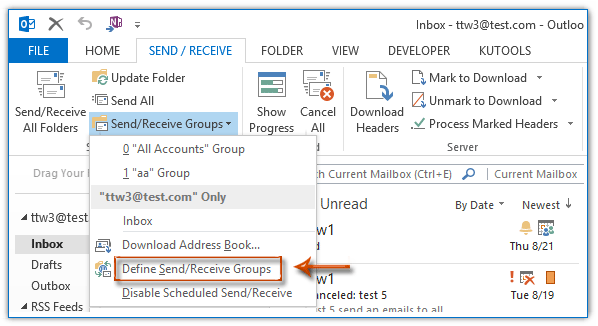Outlook For Mac Sync Frequency
Apple: Force Outlook for Mac to syncHelpful? Please support me on Patreon: thanks & praise to God, and with thanks. It deletes old entries from Google calendar and updates new appointments. User can Setup Sync Frequency as Hourly, Daily, or Weekly. Uses.Net framework 4.5. Outlook 2007 and above are supported. Calendar Sync for Outlook and Google Calendar. Software to sync Outlook Calendar appointments with Google Calendar events. In the Calendar subscription dialog box, paste the link that you copied in step 4. Also, enter a unique name for the calendar such as 'iCloud work Calendar', and click Save. You should see the iCloud calendar listed under Other calendars in Outlook on the web. When you have the same account added on Outlook for Mac, this subscribed calendar will also appear in Outlook for Mac calendar.
-->Original KB number: 2872257
Summary
Outlook for Mac provides the option to enable logging for the following features:
- AutoDiscover service
- Microsoft Exchange (folder and item synchronization)
- Microsoft Exchange Calendar
- LDAP transactions
In Outlook 2016 for Mac version 15.12.3 and later versions, the following features are also logged in addition to those listed earlier:
- Database
- IMAP
- Network Connections
- Import
- Upgrade
- Sync
More information
To enable logging in Outlook 2016 for Mac, follow these steps
Enable logging
- On the Window menu, select Sync Errors.
- In the Sync Errors window, select the Gear icon.
- Select the Turn on logging for troubleshooting option, and then select OK.
- Restart Outlook and when prompted to turn off logging select Leave Logging On and reproduce the issue you experience and then Quit Outlook to stop the log capture
To disable logging:

- Restart Outlook and when prompted to turn off logging, select Turn Logging Of. If you disable logging manually, you must restart Outlook to fully disable logging, otherwise it will continue logging in the background.
To enable logging in Outlook for Mac 2011, follow these steps
Enable logging
- On the Window menu, select Error Log.
- In the Error window, select the Gear icon.
- Select the Turn on logging for troubleshooting option, and then select OK.
- Close the Error window.
To disable logging:
- Restart Outlook and when prompted to turn off logging select Turn Logging Off. If you disable logging manually you must restart Outlook to fully disable logging, otherwise it will continue logging in the background.
Note
It is important to turn off logging after you complete your troubleshooting and reproduce the issue. If logging is not turned off, the log files size will continue to increase. If you must keep logging enabled for several hours or several days in order to capture the issue, make sure that the hard disk has sufficient free space.
Log file locations
Depending on the edition and version of Outlook for Mac in which the log is being collected, the log name and location will differ. To locate the log, see the following table.
| Outlook for Mac edition | Version | Location | File name |
|---|---|---|---|
| Outlook for Mac 2011 | 14.0.0 - 14.2.4 | ~/Desktop/ | Microsoft Outlook_Troubleshooting_0.log |
| Outlook for Mac 2011 | 14.2.5 - current | ~/Desktop/OfficeLogging/ | Microsoft Outlook_Troubleshooting_#.csv |
| Outlook 2016 for Mac | 15.3 - 15.11.2 | ~/Library/Group Containers/ UBF8T346G9.Office/OfficeLogging/ | Microsoft Outlook_Troubleshooting_#.csv |
| Outlook 2016 for Mac | 15.12.3 - Current | ~/Library/Containers/com.microsoft.Outlook/Data/Library/Logs/ | Microsoft outlook-<date>-<time>.log |
Note
The character combination '~/' in the Location column in this table refers to the Home folder of the user. This folder is located under the Users folder on the root of the hard disk.
Important
In Outlook for Mac 2011 version 14.2.4 and earlier versions, data was appended to the same log file for every Outlook session. In Outlook for Mac 2011 version 14.2.5 and later versions and in Outlook 2016 for Mac, every time that you quit and start Outlook when logging is enabled, a new log file is created.
Viewing the log file
When you collect and send the log file, Microsoft Customer Service and Support uses it to identify issues. If you are a messaging server administrator, you can use the information in the log file to diagnose issues when you troubleshoot.
The log file contains the following information:
- Issues that occur when email messages, calendar items, notes, tasks, and meeting requests are sent or received.
- Type or severity of errors, if known.
In the Outlook for Mac log collected for Outlook for Mac 2011 and Outlook 2016 for Mac through version 15.11.2, each entry has a name that identifies the feature that is being logged. The following table lists the label for each feature.
| Feature | Label that identifies the feature in the log file |
|---|---|
| AutoDiscover service | Outlook Exchange Auto Configure |
| Exchange (folder and item synchronization) | Outlook Exchange Web Services |
| Exchange Calendar | Outlook Calendar |
| LDAP transactions | Outlook LDAP |
In Outlook 2016 for Mac version 15.12.3 and later versions, the log file opens in the Console and you can view it while Outlook is running. Each entry has a name that identifies the feature that is being logged. The following table lists the label for each feature.
| Feature | Label that identifies the feature in the log file |
|---|---|
| AutoDiscover service | outlook.account.exchange.addaccount.config |
| Exchange (folder and item synchronization) | outlook.exchange.ews |
| Exchange Calendar | outlook.calendar |
| LDAP transactions | outlook.account.ldap |
| Database | outlook.database |
| IMAP | outlook.account.imap |
| Network Connections | outlook.network |
| Import | outlook.import |
| Upgrade | outlook.database.upgrade |
| Sync | outlook.sync |
Note
The log file may also contain user information. This includes user name, sender and receiver's email addresses, and the contents of the user's email messages, notes, tasks, calendar, and contacts. Microsoft does not use this information to contact users without their consent. If you are concerned that the data file contains sensitive or confidential information, you may review the contents of the data file by using text-editing software and then remove the information from the file before you send the data file to support professionals. Authentication information is not included in the log files.
EWS SyncState message size
Starting with the Outlook for Mac 2011 14.3.4 update, the size of the SyncState binary large object (BLOB) of EWS messages increased from 6 kilobytes (KB) to 32 KB and can be increased up to no more than 300 KB. If you are troubleshooting an issue in which you have to view more of this data, you must increase this value. To increase the default value of the SyncState binary large object of EWS messages, follow these steps:
Exit Outlook 2011.
Open Terminal.
To set the SyncState binary large object of EWS messages to a specific size, type the following command in Terminal window:
Note
The placeholder <max bytes> represents a byte value. For example, if you want to change the maximum byte size to 10 KB, you would type the value 10240.
To set the SyncState binary large object of EWS messages back to the default size of 32 KB, type the following command in Terminal window:
Start Outlook, and then enable Outlook logging.
 -->
-->Applies to:Outlook for Mac, Outlook 2019 for Mac
As an IT admin, you may want to provide Outlook for Mac users in your organization with a standard set of preferences in either of the following ways:
- Set a default preference, which users can change.
- Force a particular preference, which users can’t change.
The following preferences can be used to simplify account setup for Office 365 mailboxes, help protect company data, and support a streamlined user experience.
These keys are CFPreferences-compatible, which means that it can be set by using enterprise management software for Mac, such as Jamf Pro.
The following list shows the preferences that are covered in this article:
Mailbox settings
Automatically configure Office 365 mailbox on first launch
The email address used for Office activation will be added on first launch.
| Category | Details |
|---|---|
| Domain | com.microsoft.office |
| Key | OfficeAutoSignIn |
| Data Type | Boolean |
| Possible values | false (default) true |
| Availability | 16.17 |
| Comments | This key also suppresses first run dialogs for other Office apps, including Word, Excel, PowerPoint, and OneNote. |
Specify Office 365 mailbox to be added on first launch
Set the domain or full email address of Office 365 mailbox to be added on first launch.
| Category | Details |
|---|---|
| Domain | com.microsoft.Outlook |
| Key | DefaultEmailAddressOrDomain |
| Data Type | String |
| Possible values | Various (example: 'contoso.com') |
| Availability | 16.18 |
| Comments | The full email address or domain specified will be added in Outlook instead of the Office activation email address. |
Allow only corporate mailboxes to be added
Specify one or more domains users are allowed to add in Outlook.
| Category | Details |
|---|---|
| Domain | com.microsoft.Outlook |
| Key | AllowedEmailDomains |
| Data Type | Array of Strings |
| Possible values | Various (example: 'contoso.com$') |
| Availability | 16.18 |
| Comments | Format strings as regular expressions. Doesn't remove or disconnect accounts already added in Outlook. |
Hide text about adding non-corporate mailboxes
Hide the “Did you know? Outlook supports…” text in the Set Up Your Email success dialog box.
| Category | Details |
|---|---|
| Domain | com.microsoft.Outlook |
| Key | HideCanAddOtherAccountTypesTipText |
| Data Type | Boolean |
| Possible values | false (default) true |
| Availability | 16.18 |
| Comments | Only hides text. Doesn't impact ability to add non-corporate mailboxes. |
Import/export settings
Disable import
Prevent users from being able to import archive files (.olm and .pst) and Outlook 2011 for Mac data.

| Category | Details |
|---|---|
| Domain | com.microsoft.Outlook |
| Key | DisableImport |
| Data Type | Boolean |
| Possible values | false (default) true |
| Availability | 16.18 |
| Comments | Key must be set to true and forced. |
Disable export
Prevent users from being able to export archive files (.olm).
| Category | Details |
|---|---|
| Domain | com.microsoft.Outlook |
| Key | DisableExport |
| Data Type | Boolean |
| Possible values | false (default) true |
| Availability | 16.18 |
| Comments | Key must be set to true and forced. |
Online meetings settings

Disable Skype for Business online meetings
Prevent users from adding Skype for Business online meeting details to events.
| Category | Details |
|---|---|
| Domain | com.microsoft.Outlook |
| Key | DisableSkypeMeeting |
| Data Type | Boolean |
| Possible values | false (default) true |
| Availability | 16.19 |
| Comments | Key must be set to true and forced. |
Disable Teams online meetings
Prevent users from adding Teams online meeting details to events.
| Category | Details |
|---|---|
| Domain | com.microsoft.Outlook |
| Key | DisableTeamsMeeting |
| Data Type | Boolean |
| Possible values | false (default) true |
| Availability | 16.20 |
| Comments | Key must be set to true and forced. |
Security settings

Disable 'Encrypt-Only'
Prevent users from applying the Encrypt-Only option to emails when using Microsoft 365 Message Encryption.
| Category | Details |
|---|---|
| Domain | com.microsoft.Outlook |
| Key | DisableEncryptOnly |
| Data Type | Boolean |
| Possible values | false (default) true |
| Availability | 16.40 |
| Comments | Only applies to the new Outlook. |
Disable 'Do Not Forward'
Prevent users from applying the Do Not Forward option to emails when using Microsoft 365 Message Encryption.
| Category | Details |
|---|---|
| Domain | com.microsoft.Outlook |
| Key | DisableDoNotForward |
| Data Type | Boolean |
| Possible values | false (default) true |
| Availability | 16.40 |
| Comments | Only applies to the new Outlook. |
Allow S/MIME certificates without a matching email address
Allow users to decrypt and encrypt S/MIME messages when the S/MIME certificate does not match the email address.
| Category | Details |
|---|---|
| Domain | com.microsoft.Outlook |
| Key | AllowCertsWithoutMatchingEmailAddress |
| Data Type | Boolean |
| Possible values | false (default) true |
| Availability | 16.45 |
| Comments | Only applies to the new Outlook. |
Set the order in which S/MIME certificates are considered
Set the order in which certificates will be used to decrypt and encrypt S/MIME messages.
Outlook Email For Mac
| Category | Details |
|---|---|
| Domain | com.microsoft.Outlook |
| Key | SMIMECertificatesLookupOrder |
| Data Type | Array of unsigned integer |
| Possible values | 0 (Contacts), 1 (GAL), 2 (Device), 3 (LDAP) Default is [0, 1, 2, 3] |
| Availability | 16.45 |
| Comments | Only applies to the new Outlook. |
Weather location settings
Specify default weather location
Set default location for weather in calendar view.
| Category | Details |
|---|---|
| Domain | com.microsoft.Outlook |
| Key | DefaultWeatherLocation |
| Data Type | String |
| Possible values | Various (example: “Paris, France”) |
| Availability | 16.18 |
| Comments | Use the format returned by the weather location search within Outlook. |
Disable automatic updating of weather location
Prevent users from choosing Update Location Automatically for weather location.
| Category | Details |
|---|---|
| Domain | com.microsoft.Outlook |
| Key | Weather_update_automatically |
| Data Type | Boolean |
| Possible values | false (default) true |
| Availability | 16.19 |
Other settings
How To Sync Outlook Mac
Hide local folders
Prevent users from viewing local On My Computer folders in the sidebar.
| Category | Details |
|---|---|
| Domain | com.microsoft.Outlook |
| Key | HideFoldersOnMyComputerRootInFolderList |
| Data Type | Boolean |
| Possible values | false (default) true |
| Availability | 16.17 |
| Comments | Found under Outlook > Preferences > General > Sidebar. |
Specify when pictures are downloaded for email
Set when pictures are automatically downloaded from the internet for email.
| Category | Details |
|---|---|
| Domain | com.microsoft.Outlook |
| Key | AutomaticallyDownloadExternalContent |
| Data Type | Integer |
| Possible values | 0 = Never (default) 1 = In messages from my contacts 2 = In all messages |
| Availability | 16.17 |
| Comments | Found under Outlook > Preferences > Email > Reading > Security. |
Disable signatures
Prevent users from being able to create, edit, and add client-side signatures.
| Category | Details |
|---|---|
| Domain | com.microsoft.Outlook |
| Key | DisableSignatures |
| Data Type | Boolean |
| Possible values | false (default) true |
| Availability | 16.18 |
| Comments | Key must be set to true and forced. |
Specify calendar first day of week
Set the first day of week in calendar view.
| Category | Details |
|---|---|
| Domain | com.microsoft.Outlook |
| Key | CalendarFirstDayOfWeek |
| Data Type | Integer |
| Possible values | 1 = Sunday (default) 2 = Monday 3 = Tuesday 4 = Wednesday 5 = Thursday 6 = Friday 7 = Saturday |
| Availability | 16.19 |
Enable new Outlook
Set the availability and default position of the New Outlook switch.
| Category | Details |
|---|---|
| Domain | com.microsoft.Outlook |
| Key | EnableNewOutlook |
| Data Type | Integer |
| Possible values | 0 = Switch hidden (default) 1 = Switch displayed, default off 2 = Switch displayed, default on 3 = New Outlook enabled with switch hidden |
| Availability | 16.38 |